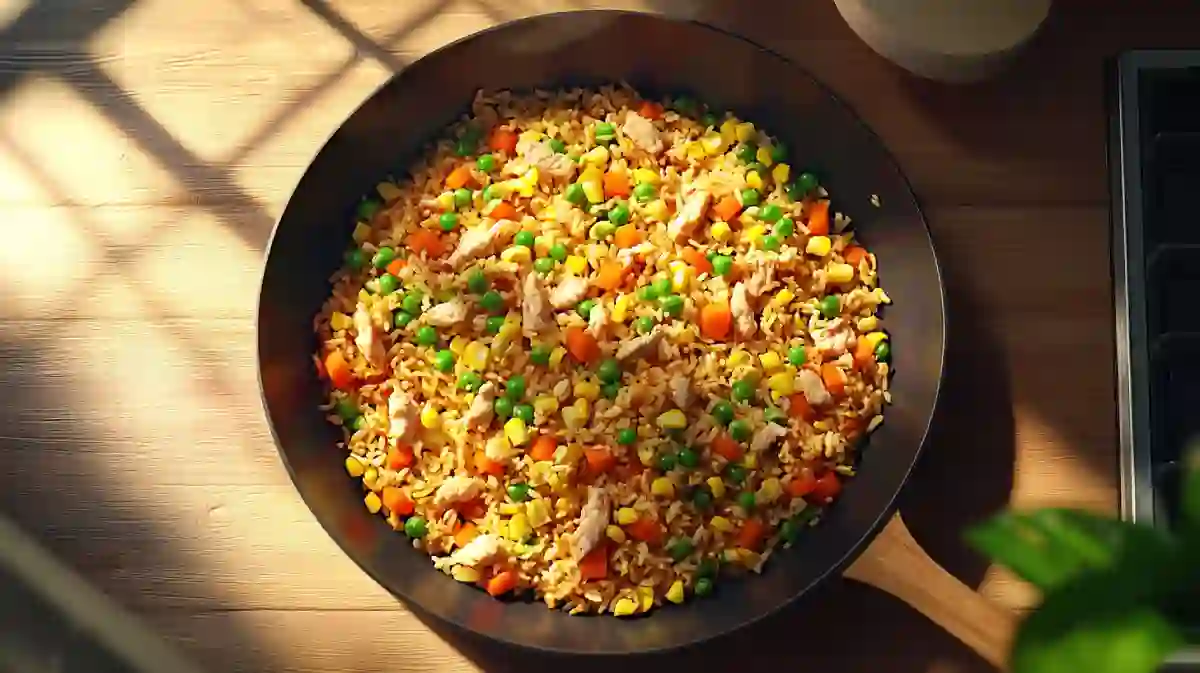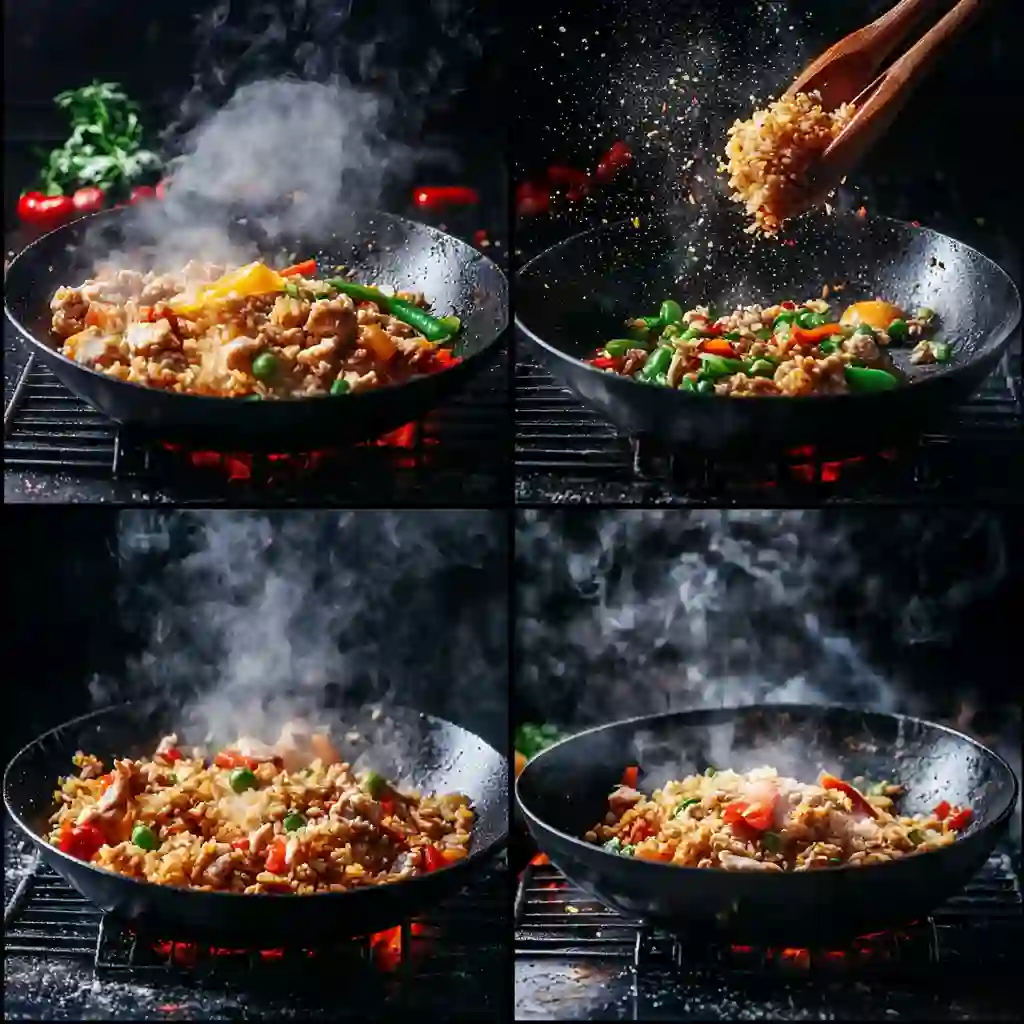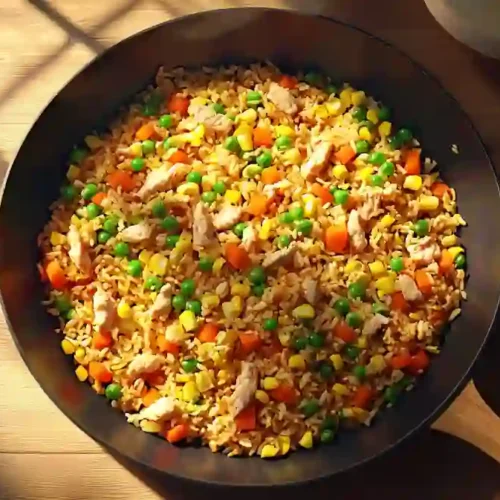
Table of Contents
Introduction
Fried rice with frozen vegetables is a quick, versatile, and delicious meal that works perfectly for any busy lifestyle. This dish combines the ease of using frozen vegetables, the practicality of leftover rice, and the delicious, savory flavors of an Asian-inspired dish. Whether you are an experienced cook or just starting out, making this recipe at home can transform your weeknight meals. Moreover, it helps reduce food waste and provides a nutritious, satisfying option for the whole family.
Not only is homemade fried rice customizable, but it is also cost-effective. You can easily tailor it to your preferences by adding proteins or using your favorite vegetables. In addition, frozen vegetables are not just convenient—they also retain most of their nutrients through flash-freezing.
If you want to achieve that authentic, smoky flavor known as wok hei, using the right tools and techniques is key. For example, cooking on high heat and spreading the ingredients evenly will help mimic the taste of restaurant-quality fried rice. Additionally, having a good wok can make a significant difference in how evenly your food cooks.
What’s more, fried rice offers endless possibilities. You can make it vegan by skipping the eggs, or you can add chicken or shrimp for extra protein. With just a few simple ingredients and techniques, this dish transforms basic staples into a flavorful meal in minutes. Follow this guide to make the most of fried rice with frozen vegetables and bring a restaurant-quality meal to your table.
Ingredients Needed for Fried Rice with Frozen Vegetables
To make fried rice with frozen vegetables, you’ll need a few simple yet flavorful ingredients. This recipe is highly adaptable, allowing you to adjust based on what you have available. Below is a breakdown of what you’ll need and why each item is essential:
Essential Ingredients
- Rice: Leftover rice works best because it is slightly drier, preventing the dish from becoming mushy. If you’re cooking rice fresh, make sure to let it cool before using.
- Frozen vegetables: A classic mix of carrots, peas, and corn is perfect, but you can add others like green beans or broccoli. Learn how frozen vegetables retain their nutrients for a healthy boost.
- Eggs: These provide protein and a rich texture. Beaten and lightly scrambled eggs are a staple in fried rice.
- Soy sauce: Adds that salty, umami depth. Light soy sauce is preferable for its delicate flavor.
- Garlic: Minced garlic enhances the aromatic qualities of the dish.
- Sesame oil: A finishing touch that adds a nutty, authentic Asian flavor.
Optional Additions
- Proteins: Cooked chicken, shrimp, or tofu can elevate the dish while adding protein.
- Flavor enhancers:
- Green onions for a fresh garnish.
- A dash of butter for a nuttier taste and golden color.
- Chili oil for a spicy kick.
For another recipe idea featuring frozen ingredients, check out this guide on creating easy and nutritious outdoor meals to pair with your fried rice.
With these ingredients, you’ll be well-equipped to create a delicious, customizable meal. By keeping your pantry stocked with staples like frozen vegetables, you can whip up this dish anytime inspiration strikes!
Preparing for the Perfect Fried Rice
To make fried rice with frozen vegetables turn out perfect every time, proper preparation is essential. By organizing your ingredients ahead of time and following a few simple steps, you’ll ensure a dish that is both flavorful and visually appealing. Let’s dive into how you can set the stage for success.
The Importance of Preparation
First and foremost, always prioritize preparation. This step not only saves time but also helps you avoid last-minute mistakes.
- Mise en place: This French term means “everything in its place.” Before you begin cooking, chop all your vegetables, beat the eggs, and measure your sauces. As a result, your cooking process will run smoothly.
- Dry rice: If you are using freshly cooked rice, spread it out on a tray and let it cool for at least 15 minutes. Therefore, the rice will not turn mushy when you cook it.
Essential Tools
To achieve the best results, having the right tools is just as important as the ingredients.
- Wok or large frying pan: A wok works best due to its even heat distribution and high sides, which prevent spills. However, if you don’t have one, a large pan can also work.
- High heat source: Cooking on high heat is crucial for developing smoky flavors. For instance, explore tips for high-heat cooking to improve your technique.
- Spatula: A sturdy spatula helps toss and mix ingredients effectively without breaking the rice.
Cooking Tips for Success
Moreover, cooking in small batches prevents overcrowding, ensuring even cooking.
- Gradually add oil and wait until it shimmers before tossing in ingredients. Consequently, this prevents sticking and enhances the frying process.
- Always keep the wok or pan hot, which helps maintain texture and flavor.
For more inspiration on quick, versatile meals, visit this helpful guide on easy outdoor recipes. It pairs well with your fried rice creations!
Step-by-Step Cooking Instructions
Cooking fried rice with frozen vegetables is a straightforward process, but following the right steps can take your dish to the next level. These instructions will help you achieve a flavorful, perfectly textured fried rice that’s ready in minutes.

Preparing the Ingredients
- Heat your wok or skillet: Start by heating a tablespoon of oil in a wok or a large frying pan over high heat. High heat ensures the vegetables cook quickly and retain their texture.
- Scramble the eggs: Pour beaten eggs into the hot pan, letting them set briefly before scrambling. Once cooked, remove the eggs and set them aside.
- Cook the frozen vegetables: Add another tablespoon of oil to the pan. Toss in your frozen vegetables and stir-fry them for 5–7 minutes until they are tender-crisp. Learn more about stir-frying frozen vegetables for best results.
Combining the Ingredients
- Add the rice: Break up any clumps in your cooked rice before adding it to the wok. Stir continuously to coat the rice evenly with the oil and prevent sticking.
- Season the dish: Pour in soy sauce, sesame oil, and a dash of white pepper. Stir well to ensure the rice absorbs the flavors evenly.
- Mix in the eggs: Return the scrambled eggs to the pan, gently mixing them with the rice and vegetables.
Final Touches
- Adjust the seasoning: Taste your fried rice and add salt or additional soy sauce if needed. Garnish with green onions for a fresh and colorful finish.
For a similar quick and nutritious recipe, explore this ultimate guide to meal prepping stir-fried vegetables.
Tips for Achieving the Best Fried Rice
Making fried rice with frozen vegetables requires more than just combining ingredients. By incorporating a few essential tips, you can elevate your dish to restaurant-quality perfection. These techniques ensure your fried rice is flavorful, textured, and satisfying every single time.
Key Tips for Success
- Cook in small batches: Overcrowding the wok or pan can cause the rice to steam rather than fry. Instead, cook in smaller portions to allow each grain of rice to crisp up properly.
- Use high heat: High heat is crucial for developing the signature smoky flavor known as wok hei. Always preheat the pan until it’s hot before adding oil or ingredients.
- Keep ingredients dry: Ensure your cooked rice and frozen vegetables are as dry as possible. Excess moisture can lead to soggy fried rice. Spread fresh rice on a tray and let it cool for 15 minutes or use leftover rice for the best results.
- Layer your seasonings: Add soy sauce, sesame oil, and spices gradually, tasting as you go. This ensures balanced flavors without overwhelming the dish.
Enhance Flavor with Variations
To add extra flavor and texture, consider these optional tweaks:
- Stir in butter during frying for a nutty aroma.
- Garnish with green onions for freshness.
- Add a dash of chili oil for a spicy kick.
For another easy recipe idea featuring pantry staples, explore this customizable sub-in-a-tub recipe, which pairs well with a serving of fried rice for a quick and nutritious meal.
Variations of Fried Rice with Frozen Vegetables
One of the best aspects of fried rice with frozen vegetables is its versatility. You can easily adapt the recipe to suit your preferences or dietary needs. Whether you’re adding protein, experimenting with flavors, or catering to specific diets, there are countless ways to customize this dish. Let’s explore a few popular variations:
Protein-Packed Options
- Chicken Fried Rice: Add diced, cooked chicken breast or thigh for a hearty protein boost. Stir-fry the chicken separately before mixing it into the rice.
- Shrimp Fried Rice: Include sautéed shrimp for a seafood twist. The natural sweetness of shrimp pairs wonderfully with soy sauce and vegetables.
- Tofu Fried Rice: For a vegetarian alternative, pan-fry cubes of tofu until golden before tossing them in.
Spicy and Flavorful Twists
- Chili Oil Fried Rice: Add a spoonful of chili oil to give your dish a spicy kick. This works well for those who love bold flavors.
- Garlic Butter Fried Rice: Mix in melted garlic butter for a rich, nutty flavor that enhances the dish’s savory elements.
Dietary Adaptations
- Gluten-Free Fried Rice: Replace regular soy sauce with tamari or a gluten-free soy sauce alternative.
- Vegan Fried Rice: Skip the eggs and add extra vegetables or pan-fried tofu for texture and protein.
For more creative and delicious variations, consider trying this customizable sub-in-a-tub recipe, which complements fried rice for a versatile meal plan.
Health Benefits of Using Frozen Vegetables
Incorporating frozen vegetables into your fried rice with frozen vegetables not only makes cooking more convenient but also adds numerous health benefits. While some may assume fresh vegetables are always better, frozen vegetables can be just as nutritious, if not more so, in certain situations. Here’s why:
Key Nutritional Benefits
- Nutrient Retention: Frozen vegetables are typically flash-frozen shortly after harvest, which helps lock in vital nutrients such as vitamins and minerals. This process often makes them as healthy as fresh vegetables from the store.
- Low in Calories: Most frozen vegetables are naturally low in calories, making them a great addition to fried rice without adding excess energy.
- High in Fiber: Options like peas, carrots, and broccoli are rich in fiber, which aids digestion and promotes a feeling of fullness.
Practical Advantages
- Convenience: With frozen vegetables, there’s no need to wash, peel, or chop, saving time and effort in meal preparation. This is especially helpful for quick weeknight dinners.
- Reduced Waste: Since they are preserved at peak ripeness, frozen vegetables last much longer than fresh produce, reducing food waste.
- Affordable: Frozen vegetables are often more affordable than their fresh counterparts, providing a budget-friendly way to include more veggies in your diet.
Variety for Balanced Nutrition
Using a mix of vegetables, such as carrots, peas, and corn, ensures a range of nutrients and flavors. This combination also keeps your fried rice colorful and visually appealing.
By incorporating frozen vegetables, you can enjoy a nutritious, balanced meal that’s quick to prepare. Not only do they simplify cooking, but they also allow you to create wholesome dishes without sacrificing taste or quality.
Frequently Asked Questions About Fried Rice with Frozen Vegetables
When it comes to making fried rice with frozen vegetables, several common questions arise. Whether you’re new to cooking this dish or looking for tips to improve your technique, here are some answers to frequently asked questions.
Can I Use Freshly Cooked Rice Instead of Leftover Rice?
Yes, you can use freshly cooked rice. However, it’s essential to let it cool and dry slightly before adding it to your fried rice. Spread the rice on a tray and allow it to sit for 15–20 minutes to remove excess moisture, ensuring the grains don’t clump together.
Should I Thaw Frozen Vegetables Before Using Them?
No, it’s not necessary to thaw frozen vegetables before stir-frying. You can add them straight from the freezer into the hot pan. This method retains their crisp texture and prevents them from becoming soggy.
What Type of Oil Should I Use?
Choose oils with a high smoke point for cooking, such as canola oil, which is neutral in flavor and affordable; peanut oil, which adds a subtle nutty taste; and vegetable oil, which is widely available and versatile.
Can Fried Rice Be Made Gluten-Free?
Absolutely! Replace regular soy sauce with tamari or any gluten-free soy sauce alternative. Be sure to check the labels of other seasonings to avoid hidden gluten.
How Do I Store Leftovers?
Fried rice can be stored in an airtight container in the refrigerator for up to three days. Reheat it in a hot pan or microwave to bring back its original texture and flavor.
Can You Use Frozen Rice to Make Fried Rice?
Yes, You Can: Frozen rice works well for fried rice and is often preferred because its drier texture prevents clumping.
Conclusion
Fried rice with frozen vegetables is a versatile, quick, and satisfying dish that fits effortlessly into any mealtime routine. Its simplicity, combined with the ability to customize it to your taste and dietary preferences, makes it a favorite among busy cooks and food enthusiasts alike.
Key Takeaways
- Convenience: With frozen vegetables and leftover rice, this dish comes together in minutes, making it ideal for weeknight dinners.
- Health Benefits: Packed with fiber, vitamins, and minerals, it’s a nutritious meal that doesn’t compromise on flavor.
- Customizable Options: Whether you prefer adding chicken, shrimp, or tofu, or making it vegan or gluten-free, fried rice adapts beautifully to your needs.
- Cost-Effective: Using simple ingredients, often already in your pantry, keeps this dish budget-friendly.
Why You Should Try This Recipe
Not only is this dish easy to prepare, but it also allows you to reduce food waste and experiment with different flavors. By following the outlined steps and incorporating the tips provided, you’ll consistently achieve restaurant-quality results. Plus, its adaptability means you can enjoy endless variations to keep your meals exciting.
In conclusion, fried rice with frozen vegetables is a culinary classic that offers something for everyone. Whether you’re cooking for yourself or feeding a family, this recipe promises to be a go-to solution for delicious, stress-free dining. Start experimenting today, and make this dish a regular on your menu!

Fried Rice with Frozen Vegetables
Ingredients
- 3 cups cooked white rice cold
- 2 tablespoons vegetable oil
- ½ cup onion chopped
- 6 ounces frozen mixed vegetables e.g., peas, carrots, corn
- 2 cloves garlic minced
- 2 large eggs lightly beaten
- 2 tablespoons soy sauce
- 1 teaspoon sesame oil
- Salt and freshly ground black pepper to taste
- Optional: chopped green onions for garnish
Instructions
- Prepare Ingredients: Ensure all ingredients are measured and ready. If using freshly cooked rice, allow it to cool completely to prevent clumping.
- Cook Aromatics: Heat 1 tablespoon of vegetable oil in a large skillet or wok over medium-high heat. Add the chopped onion and sauté until translucent, approximately 2-3 minutes.
- Add Garlic and Vegetables: Stir in the minced garlic and cook until fragrant, about 30 seconds. Add the frozen mixed vegetables and cook until they’re heated through and any excess moisture has evaporated, around 3-4 minutes.
- Incorporate Rice: Push the vegetables to one side of the skillet. Add the remaining tablespoon of vegetable oil to the empty side, then add the cold rice. Gently break up any clumps and combine with the vegetables, stirring continuously for about 2 minutes.
- Cook Eggs: Create a well in the center of the rice mixture. Pour in the beaten eggs and scramble until fully cooked. Once done, mix the eggs evenly throughout the rice and vegetable mixture.
- Season the Dish: Pour in the soy sauce and sesame oil, stirring well to ensure even distribution. Season with salt and freshly ground black pepper to taste. Cook for an additional 1-2 minutes, allowing the flavors to meld.
- Serve: Remove from heat and garnish with chopped green onions if desired. Serve immediately.
Notes
- Rice Preparation: Using day-old, refrigerated rice yields the best texture for fried rice. Freshly cooked rice can result in a mushier consistency.
- Vegetable Options: While a standard mix of peas, carrots, and corn is common, feel free to incorporate other frozen vegetables like green beans or broccoli for variety.
- Protein Additions: To make this dish more substantial, consider adding cooked chicken, shrimp, tofu, or other proteins during the cooking process.
- Flavor Enhancements: For added depth, include a dash of oyster sauce or a sprinkle of chili flakes for heat.
- Storage: Leftovers can be stored in an airtight container in the refrigerator for up to 3 days. Reheat in a skillet over medium heat for best results.
| Tested by MacMar – recipe developer at Flavivo Recipes. This 15-minute skillet was timed twice to prove frozen veggies cook through without thawing and rice stays fluffy. |
